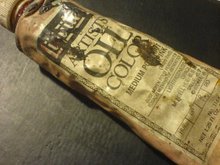THE DOWNSIDE OF BEING FILIPINO
Published as a boxed article by the Inquirer on 24 Nov 2006, the only comment published in full. Other replies and rejoinders, including Jon Red's were parsed and compiled by staffwriter Marinel Cruz.
Dear Inquirer,
This is in response to UP Film Institute's Prof. Tilman Baumgartel's article, "The Downside of Digital," (Sept 24, sec J2). I'd like to thank the professor for playing Devil's Advocate, and for this opportunity to comment.
The professor's concerns seem to have resulted from seeing too much crappy amateur work. For at the professional level, digital isn't easy at all. It's actually more difficult to use than film.
With digital, you've got the worst of both worlds: the intolerance of slide film, and the lighting principles of negative film.
Like slides, digital has a painfully short tonal range (5.5 stops vs neg's 12), and is very intolerant of over exposure (0.5 stops tolerance vs neg's 10 stops). Yet, unlike slides, to get good blacks in digital you must STILL over-light the set (like negs), and then stop your shutter down.
Digital is also infamously sharp. Selective focus is frequently impossible, forcing art departments to work doubly hard, just to keep distracting visual elements under control-- and that includes everything from pimple scars and stretch marks to shoddy set design and windswept weeds dancing in the background.
The Devil's Advocate shouldn't worry about digital films being branded as cheap, either, because they aren't necessarily so. Digicams sell for a fraction of their film-based equivalents, admittedly, but all digital gear becomes outdated every 18 months or so (if they don't fall apart before that), whereas built-like-tanks film cams depreciate over 10-15 years (and remain serviceable decades after). Also, until digital distribution/exhibition systems become available, digital footage needs expensive 35mm blow-ups for commercial release.
Nor should the professor worry about the cinematic "Philippine night." Pro digital, when done right, actually does better night scenes than film nowadays, if you can afford the post-production. As a matter of fact, cinematographer Dion Beebe shot 80% of Michael Mann's COLLATERAL (2004) in HD, precisely because HD handles low-light situations better than negative film (slide film would theoretically be better, but you just don't shoot with slide film these days).
But this doesn't mean celluloid is dead. Being continuous-tone images, old celluloid movies could easily be re-scanned with future technologies, whereas digitally shot films remain at their original resolution, and could only look increasingly pathetic over time. Besides, the digital equivalent of a 35mm frame is a 6MP image. It will take at least two decades more before we see cable-free 6MP movie cameras shooting at 172 frames per second. And who knows how far film chemistries and economies of scale would have improved by then?
And so, since pro digital is more difficult and is neither better nor cheaper, it is obvious why Filipino artists are embracing it at all: poverty. We can't afford to plunk massive fortunes up front for Arricam 535s or PanaVisions that will last forever, so we'll just pay smaller fortunes for flimsy, user-hostile HD gear that quickly becomes worthless. It's a bargain we have to make if our stories are to be told at all.
Is the Filipino audience still worthy of such a sacrifice? This, to me, is the true dark night of Philippine Cinema today, and an issue that requires another Devil's Avocate altogether.
Me? I have never given up on the Filipino artist, but I have long since given up on the Filipino as a public for art.



No comments:
Post a Comment